Delhi tourist places, It is the capital of India. It serves as the center of the Government of India and the National Capital Territory of Delhi. Delhi is also famous for many tourist attractions like Akshardham, India Gate, Qutub Minar, and many more.
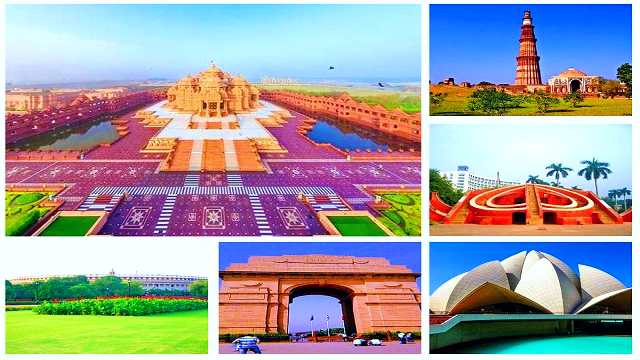


New Delhi is located within the Delhi metropolis and is one of the eleven districts of the Union Territory of Delhi. The capital of India was Calcutta (now Kolkata) until 1911 during the British rule over India. The population of Delhi makes it the fifth most populous in the world, and India’s largest metropolis. Even by area, Delhi is one of the largest metros in the world. After Mumbai, it is the second richest city in the country, and Delhi’s GDP ranks second among cities in South, West, and Central Asia. New Delhi is known for its wide roads, tree-lined roads, and many of the country’s top institutions and landmarks.
- 17 Famous Delhi tourist places
- Akshardham Temple Delhi tourist places
- Qutub Minar Delhi tourist places
- Red Fort Delhi tourist places
- India Gate Delhi tourist places
- Rashtrapati Bhavan Delhi tourist places
- Parliament Delhi tourist places
- Birla Temple Delhi tourist places
- Lotus Temple Delhi tourist places
- Gurdwara Bangla Sahib Delhi tourist places
- Jantar Mantar Delhi tourist places
- National Zoological Park Delhi tourist places
- Humayun Tomb Delhi tourist places
- Purana Quila Delhi tourist places
- Nehru Planetarium Delhi tourist places
- Jama Masjid Delhi tourist places
- Delhi Haat Delhi tourist places
- Safdarjung Tomb Delhi tourist places
- How to Reach Delhi
- Where to stay in New Delhi
- Best Time To Visit New Delhi
- New Delhi travel guide
- New Delhi Itinerary
- New Delhi Travel Cost for 1 Couple for 1 Night & 3 Days.
17 Famous Delhi tourist places
Akshardham Temple Delhi tourist places
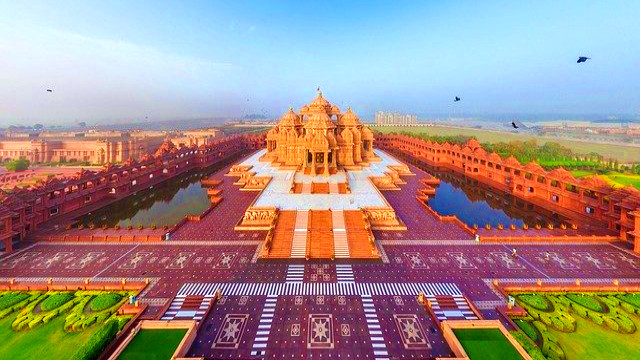


The city of Delhi is a city attracting people, both culture and religion attract people here. Another reason for the attraction is the Akshardham Temple built here – Akshardham Temple which is also known as Swaminarayan Temple. Swaminarayan Akshardham Temple is a famous temple in India located in Delhi. Akshardham Temple was opened in the year 2005, which is dedicated to Lord Swaminarayan. Akshardham Temple situated on the banks of Yamuna Adi reflects Hinduism and its ancient culture.
The most special thing about this temple is that this temple has made its place in the Guinness Book of World Records as the world’s largest comprehensive Hindu temple. The main statue of Swaminarayan Akshardham Temple is the statue of Swaminarayan and along with this are the murtis of 20,000 celestial legends of India. The temple is said to have been constructed with intricately carved marble and sandstone. This temple is spread over 100 acres of land. Akshardham Temple takes the tourists coming here on a journey of spiritual knowledge. After visiting the temple, the devotees get a wonderful enjoyment.
Akshardham Temple
A traditional temple dedicated to Lord Swaminarayan offers a glimpse of the beauty and spirituality of India’s ancient art, culture, and craft.
Neelkanth varniabhishek
An iconic spiritual tradition, in which prayers of universal peace and unending peace are offered to individuals, family and friends for which the waters of 151 holy rivers, lakes, and ponds of India are used.
Exhibitions
Hall 1 – Hall of Values (50 mins)
Experience sustainable human values through films and robotic shows that mention non-violence, honesty, and spirituality.
Hall 2 – Film on a huge screen (40 minutes)
Get to know India through the incredible story of an eleven-year-old yogi named Neelkanth, who has brought Indian customs to life through culture and spirituality, the beauty of its art and craft, and the unforgettable visuals, sounds, and its Experience the power of inspiring festivals.
Hall 3 – Cultural Boat Ride (15 minutes)
It celebrates 10,000 years of India’s magnificent heritage. See the discoveries and inventions of the sages-scientists of India, see Taxila, the world’s first university, go through the caves of Ajanta-Ellora, and know about India’s contribution to humanity since ancient times.
Musical Fountain – Life cycle (in the evening after sunrise – 15 minutes)
A spectacular musical fountain show, in which the birth, lifetime, and death cycles correspond to Indian philosophy
Lotus Garden
A lotus-shaped garden gives an impression of the spirituality expressed by philosophers, scientists, and leaders.
Akshardham Temple has another attractive garden which is also called Kamal Bagh, it is named after its shape. This garden is a form of purity. It is said that many great men of history, philosophers, and scientists came to this garden.
Qutub Minar Delhi tourist places



Qutub Minar is the world’s tallest tower made of brick, located in Mehrauli part of South Delhi city in India. It is 72.5 meters (237.86 ft) in height and 14.3 meters in diameter, which rises to 2.75 meters (9.02 ft) at the summit. It has 379 steps. The courtyard built around the tower contains many outstanding specimens of Indian art, many of which date back to 1192 AD. The complex has been approved by UNESCO as a World Heritage Site.
It was built as a 73 m high Vijay Minar in 1193 by QutubuddinAibak soon after the defeat of the last Hindu ruler of Delhi. This building has five floors. Each floor has a balcony and a base of 1.5 m. Is a diameter of 2.5 meters at the top which gradually decreases and the first three floors are made of red sandstone and the fourth and fifth floors are made of marble and sandstone. Adjacent to the tower is the first Quatul-Islam mosque in India. It is built from the ruins of 27 Hindu temples from its remains. “The mosque has a 7-meter high iron pillar in the courtyard. It is said that if you siege it behind it, it will be your wish. Will go.
The construction of Qutub Minar is controversial. Some believe that it is seen as the beginning of Muslim rule in India as a tower of victory. Some believe that it was created to offer azaan to the muazzin.
However, almost everyone is unanimous about this. That this tower is a monument not only in India but in the world. QutubuddinAibak, the first Muslim ruler of Delhi, started its construction in 1200 AD but he was able to complete only its base. His successor Altamash built three floors of it and in 1368 Ferozeshah Tughlaq built the fifth and final floor.
The development of the architectural style from the Aibak to the Tughlaq period is evident in this tower. There is also a difference between the construction material used and the maintenance material. The base of 238 feet Qutub Minar is 17 feet and its top is 9 feet. The tower is decorated with inscriptions and has four balconies. In which elaborate brackets are made. The Quat-e-Islam (Noor of Islam) mosque is also considered a magnificent mosque in the world even in the ruins of the Qutb complex. Qutubuddin-Aibak started its construction in 1193 and in 1197 the mosque was completed.
In the year 1230, Altamash and in 1315 Alauddin Khilji expanded this building. The inner and outer walls of this mosque are in pillar ranges. The magnificent pillars are set up around the inner furnished lats. Most of these lots are made from the remains of 27 Hindu temples. They were looted for the construction of the mosque, so it is not a matter of conduct that this mosque is traditionally a form of Hindu architecture. Surrounding the mosque is the stunning iron pillar of Delhi.
History of Qutub Minar
Qutub Minar means ‘Dhruva’ or ‘Dhuri’ in the Arabic language. Qutub Minar is the highest tower in India. This tower is marked as the first identity of the Muslim community in North India. This tower was built in Delhi to commemorate a powerful victory, leaving behind the defeat of the previous Hindu Empire.
Who is affected by Qutub Minar
The Qutub Minar in India represents the prototype of all minarets. It was influenced by the breezy Victory Pillar in Ghazni, Afghanistan. The iron pillar in the Qutub Minar complex has not rusted even after 2000 years. Parts of the Qutub Minar complex have been constructed outside the Hindu temples, which can be clearly seen in the Kuwait-ul-Islam Mosque.
Construction of Qutub Minar
Qutub Minar was built in 1199 AD by Qutub al-Din Aibak, the founder of the Delhi Sultanate. The tower was built on the ruins of the Red Fort of Lal Kot in the city of Dhilika. Iltutmish, the successor of Aibak, completed its construction by adding three more stories to complete the tower of Qutub Minar.
Who named the Qutub Minar?
It cannot be definitively named after whom the Qutub Minar was named. Its claimants include the name of two people – Qutb al-Din Aibak Emperor, the founder of the Delhi Sultanate, who built it, and the other Qutbuddin Bakhtiar Kaki, who was a famous Sufi saint.
Qutub Minar Design
The architectural culture of the tower was established before the Turks arrived in India. However, there is no such record or any evidence to confirm that the design of Qutub Minar is influenced by the Rajput towers built earlier.
Repair of Qutub Minar
Several inscriptions written in Perso-Arabic and Nagari letters in different sections of Qutub Minar reveal the history of its construction. According to the inscription written on its surface, the Qutub Minar was repaired by Feroz Shah Tughlaq (1351–1389) and Sikander Lodi (1489–1517).
When the size of Qutub Minar increased
Kuwait-ul-Islam Mosque is located to the north of Qutub Minar. It was built in 1192 by Qutb al-Din Aibak. It is one of the oldest mosques in the Indian subcontinent. Later this mosque has been rebuilt by Iltutmish (1210-1235) and Ala-ud-din Khilji and its size has been increased.
Red Fort Delhi tourist places
The capital of India is Delhi, in which the Red Fort is known as a historical fort. This fort is a very special place for tourists in India. And tourists from other countries also like to see this fort of India. Talking about this fort, let us tell you that till 1856, this fort was ruled by the emperors of the Mughal dynasty for almost 200 years. It is located in the center of Delhi and also has many museums. This fort was the formal and political center of the Mughal state, apart from the emperors and their home, and the region was specially set up for the assembly. If you are planning to visit the Red Fort, then this place can be very special for you, but before you go here, you should know any information about this place, which we are going to tell you with the help of this article.
Red Fort visiting Place built-in Red Fort
The structure of the Red Fort is mainly its walls, main door, audience hall, a royal palace built on the banks of river Yamuna. Apart from this, below you are told other places –
Chhabri Bazaar – It is present in front of Red Fort.
Lahori Darwaza- This is the main door of the Red Fort, it was given this name due to facing Lahore. The flag is hoisting every year since independence, and from the balcony here, the Prime Minister reads his message to the country.
Delhi Darwaza – It is on the south side of the fort. Its form, texture is exactly like the main Lahori door. Both of the doors and huge elephants of stone remain. It was disbanded by Aurangzeb, but in 1903 it was rebuilt by Lord. Pani Darwaza- This is a small door, located in the southeast. It was near the banks of the river, so it got its name.
Chatta Chowk – There is a Chatta Bazaar as soon as you enter from Lohore Gate, here used to put hearts in the time of Mughals, where silk, jewelry, and other items were sold.
NaubatKhana – This is also called NakarKhana. It is located on the eastern side of Lahore Gate, this palace was specially built for musicians, where the musical evening was held at night. Diwan-e-Aam – This used to be the main court of the king, here they used to make all decisions. It was built 540 feet wide and 420 feet deep. The gallery was built around it. There was also a hall for the public in front of it.
Mumtaz Mahal – It was built for the wife and tens of kings, there is a museum here today. Rang Mahal – Like Mumtaz Mahal, it was built for the queens. There was also a pool in the middle which was filled by the Nahr-e-Bahisht (it was a canal that connected the palace with the Yamuna river).
Deewane Khas – Deewane mango was made northern and Diwane Khas. It was made of Sangram and precious stones. It used to be the personal room of the king, it was also made of precious stones and gems. Moti Masjid – It was built by Aurangzeb in 1659, it was Aurangzeb’s private mosque.
Red Fort Security –
To avoid terrorist attacks, the security of the Red Fort is taken full care of. Its security is further strengthened during Independence Day. Delhi Police and military teams monitor it well. This is a no-fly zone area, meaning no plane can fly from here.
The Red Fort is the heritage of our country, which is the responsibility of our countrymen. We have to keep it completely safe. The Red Fort has seen the rule of many kings, it has seen the happiness of a king and the sorrow of someone. Along with the ayashi of the Mughals, Raunkeen has also seen the British oppression. We are proud of our Indian heritage.
India Gate Delhi tourist places
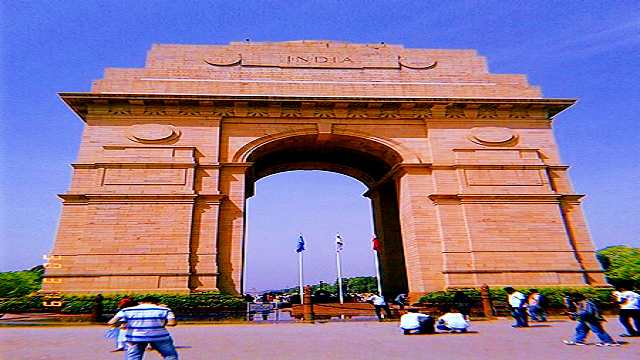


India Gate, (originally called the All India War Memorial), is a massive 42-meter high instrument located on the Rajpath in New Delhi. It is the national monument of independent India, formerly called Kingsway. The monument is descended from the Arc de Triomphe in Paris. It is constructed from red sandstone and granite.
It was built and inaugurated on 12 February 1931, India Gate is known as the All India War Memorial, this monument was built by the British rulers in memory of the 90,000 Indian soldiers who served in the British Army. And was martyred in World War I and the Afghan Wars. The names of 13,300 soldiers, including some soldiers and officers, are engraved on the gate. When India Gate was ready, a statue of George V was placed in front of it.
Which was later installed in the Coronation Park along with other sculptures from the time of the British Raj. Now, instead of the statue of George V, only one canopy is left as a symbol. Every year on Republic Day (26 January), the dignitaries along with the President of India and many other main political leaders are remembered for the dedication of those martyrs at the Amar Jawan Jyoti located below India Gate. And on 26 January every year, the Republic Day parade takes place at India Gate. Several tableaux are presented to reflect the culture of India. To see which the President is invited as a guest from abroad.
Rashtrapati Bhavan Delhi tourist places
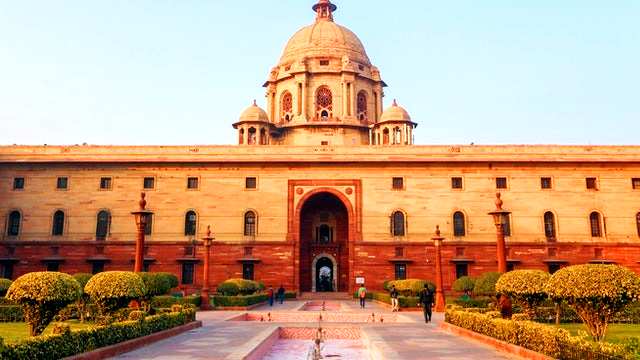


It is the official residence of the President of the Government of India. Till 1950, it was known as Viceroy House. Then it used to be the residence of the then Governor-General of India. It is situated in the heart area of New Delhi. The palace has 360 chambers and is bigger than the residence of any head of state in the world. The present President of India does not live in the chambers where the Viceroys lived but in the guest hall.
The grandeur of the Rashtrapati Bhavan is multifaceted. It is a huge building and its architecture is breathtaking. More than that, it holds a proud place in the history of democracy because it is the residence of the President of the world’s largest democracy. In terms of size, spaciousness, and grandeur, only a few heads of state of the world will be able to match Rashtrapati Bhavan, the official residential complex. An amount of 400000 pounds was sanctioned for this building.
But the construction of this building took a long time of 17 years, raising its cost to 877,136 pounds (12.8 million at that time). Apart from this building, the actual expenditure on Mughal Gardens and staff accommodation was 14 million. Edwin Lutyens is said to have said that the amount of money that went into the construction of this building was less than the amount of money it cost to build two warships.
It is an interesting fact that the building which had a time limit of four years was completed, it took 17 years to build and India became independent in the eighteenth year of its construction. This huge building has four floors and has 340 rooms. 700 million bricks and three million cubic feet of stone were used in the construction of this building with a built site of 200000 square feet. Steel has been used very little in the construction of this building.
The most prominent and distinctive aspect of Rashtrapati Bhavan is its dome which is prominently installed above its structure. It is visible from quite a distance and has an interesting circular roof resting on a circular base in the heart of Delhi. Although Lutyens has apparently accepted the design of this dome from the Pantheon of Rome, it is strongly believed by informed analysts that the structure of this dome was built on the design of the great stupa at Sanchi.
The prominence of Indian architecture in this dome is evident from the fact that it is surrounded by railings of Sanchi origin. In fact, the entire Rashtrapati Bhavan is the embodiment of Indian architectural designs such as Buddhist railings, balconies, canopies, and nets. The power and authority of the people of India, which is prevalent in this republic, is represented by the President of this country, whose official residence is Rashtrapati Bhavan, and the building whose architecture is dedicated to dedicated architects and common people from all over the world.
Parliament Delhi tourist places
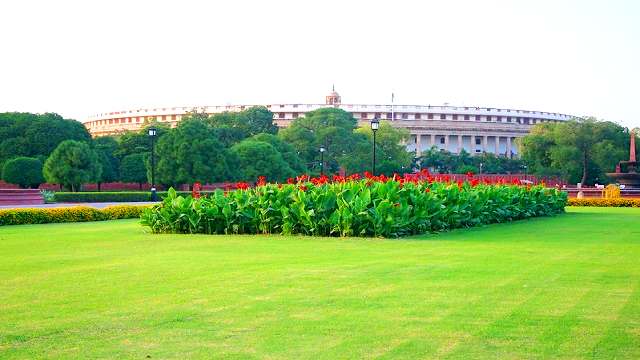


Parliament is the highest legislative body in India. This is a bicameral system. The Indian Parliament consists of the President and two Houses – Lok Sabha (House of the People) and Rajya Sabha (Council of States). The President has the power to summon or adjourn either House of Parliament or dissolve the Lok Sabha. The Parliament of India operates in the ‘Parliament House’. Which is located in New Delhi.
The Parliament of India operates in the ‘Parliament House’. Which is located in New Delhi. The Rajya Sabha is called the upper house and the Lok Sabha is called the lower house. But it is only said in practice. Because nowhere in the Indian constitution has the term lower house been used for Lok Sabha and upper house for Rajya Sabha.
The Lok Sabha consists of representatives elected by the people of the nation whose maximum number is 550. Rajya Sabha is a permanent house with a maximum of 250 members. Rajya Sabha members are elected/nominated for 6 years. 1/3 of whose members retire every 2 years. At present, the number of members of Lok Sabha is 543 and the number of members of Rajya Sabha is 245.
India’s political system, or the way a government is formed and run, is called parliamentary democracy. Gram panchayats have been an integral part of our public life. In olden times, panchayats of villages were formed by-elections. He had a lot of authority in both the areas of justice and order. Members of the panchayats had great respect in the court.
These panchayats were used to distribute land. Used to collect taxes. The government used to pay part of the tax on behalf of the village. Used to collect taxes. The government used to pay part of the tax on behalf of the village. Somewhere there was a large panchayat above many gram panchayats. It is used to monitor and control them. Some earlier inscriptions also reveal how members of gram-panchayats were elected. The qualities required to become a member and the rules of women’s participation in elections were also written on it.
Any member could be removed from the post for not doing good conduct or not being able to properly account for state money. No close relative of any member could be appointed to the posts. The Parliament is the highest representative body of the people in Indian democracy. It is through this that the sovereignty of the common people gets expressed. Parliament is the proof that the public is at the top of our political system, public opinion is paramount.
The word ‘parliamentary’ itself means such a democratic political system where the supreme power lies in that body of representatives of the people, which is called ‘Parliament’. The Federal Legislature is called ‘Parliament’ under the Constitution of India. It is the axis that is the foundation of governance of the country. The Indian Parliament is made up of the President and two Houses — the Rajya Sabha and the Lok Sabha.
Birla Temple Delhi tourist places
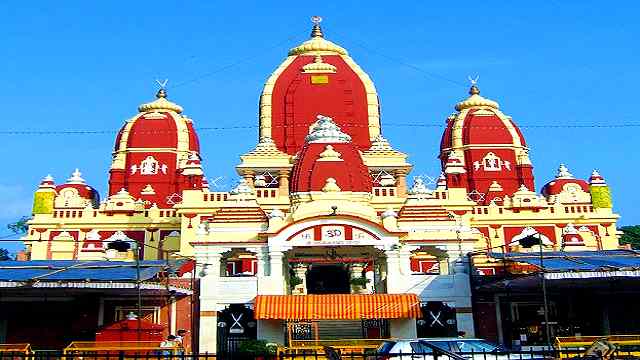


The Birla Temple in Delhi is also known as the Lakshmi Narayan Temple. Construction of this major attraction of metro industrialist G. Inaugurated by D. Birla which was completed in 1939 and inaugurated by Mahatma Gandhi. One of the most beautiful temples in Delhi, this temple is dedicated to Goddess Lakshmi (goddess of wealth and wealth) and Narayana (her husband and foster of Trimurti).
Apart from this, there are small temples dedicated to Lord Krishna, Shiva, Ganesh, Hanuman, and Buddha around this temple. There is also a temple dedicated to Goddess Durga – the goddess of power. Built-in the city-style of Hindu temple architecture, this temple was constructed under the guidance of a person named Pandit Vishwanath Shastri, and after its completion,
Mahatma Gandhi agreed to its inauguration on the condition that people of all religions and castes in this temple Will be allowed entry. Spread over an area of 7.5 acres, the temple complex consists of attractive green gardens and fountains that attract thousands of tourists every year, mostly during Diwali and Janmashtami. Located on the Mandir Marg near Connaught Place, this temple is easily accessible by all modes of transport and is open from 6 am to 10 pm seven days a week.
Lotus Temple Delhi tourist places
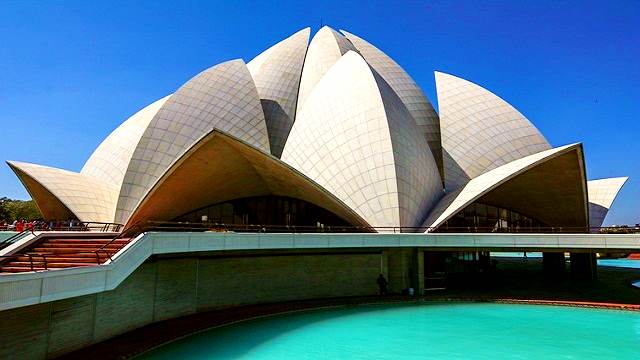


The Lotus Temple or Lotus Temple is a Baha’i (Iran, a follower of a different Dharna founder, Baha’u’llah) place of worship located near Nehru Place (Kalkaji Temple) in the Indian capital, Delhi. It is a unique temple in itself. There is neither an idol nor any religious rituals of any kind are done here, on the contrary, various sacred articles related to different religions are read here.
For the people of India, the lotus flower is a symbol of purity and peace, as well as a sign of the incarnation of God. This flower teaches us to be pure and clean despite blooming in the mud, as well as reflecting how one can be most detached by living within religious competition and material prejudices. The Lotus Temple receives around eight to ten thousand tourists from India and abroad every day.
The serene atmosphere here is helpful for prayer and meditation. The temple was inaugurated on 24 December 1949, but for the general public, this temple was opened on 1 January 1949. Due to its lotus-like shape, it is called by the name Lotus Temple or Lotus Temple. The Bahai Upasana Mandir is one of those temples that enlighten the glory, peace, and exquisite atmosphere, which is essential for any devotee to be spiritually encouraged.
Upasana Mandir provides information to visitors in media publicity and audio mediums to attract tourists to the temple, thousands of people are attracted here from the temple without elaborate meadows, white giant buildings, tall domed prayer halls, and statues, not just as spectators, but to pray and meditate and pray at the scheduled time Also come to participate in This special prayer are held for five minutes at every hour. In summer, the information center opens at 7:30 AM, which is closed at 7:30 PM. While in winter its time is ten to five in the morning. Not only this, people sit in the library of Upasana temple and also read books of religion and come to research them. The architecture of the temple has been designed by architect Fariborz Sahaba.
After the construction of this temple, a need was felt for a place where the questions of all the curious could be answered easily. A decision was then taken about the formation of the Information Center. The construction of the information center took about five years. It was opened to the curious in March 2003. The Information Center houses the main auditorium, which can seat around 600 people simultaneously. Apart from this, there are also two small auditoriums, which have about 40 seats. In the information center, people are also given information about the Bahá’í religion. Along with this, visitors are informed about the Lotus Temple. There are a total of seven Bahá’í temples worldwide with this temple. The eighth temple is also going to be built soon.
Apart from the Lotus Temple of India in the Indian subcontinent, there are six temples in Appia-Western Samoa, Sydney-Australia, Kampala-Uganda, Panama City-Panama, Frankfurt-Germany, and the Wilmont-United States. Each worship temple resembles some basic design, while some are different in reflecting the cultural identities of their respective countries. From this point of view, this temple realizes the principle of ‘unity in diversity. All these temples have universal character – it has nine gates and nine corners. Nine is believed to be the greatest number and represents expansion, unity, and integrity. TheThe Upasana Temple is surrounded by nine large reservoirs all around, which not only enhances the beauty of the building but also contributes significantly to keeping the temple prayer room naturally cool.
The Bahai Upasana Temple is one of the temples that give glory to peace and an exquisite atmosphere. Upasana Mandir provides information to visitors in media publicity and audio mediums. This white-colored marble building looks amazing in the morning and evening redness. The dug and greenery around the building, standing like a lotus petal, make it peaceful and refreshing in a noisy area.
Gurdwara Bangla Sahib Delhi tourist places
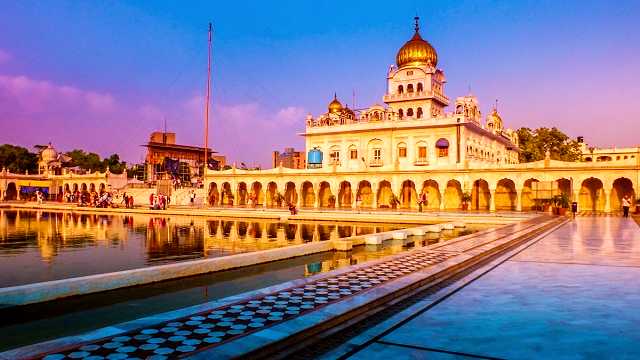


Gurdwara Bangla Sahib is one of the most important gurdwaras in Delhi. It is recognized immediately by its golden ornamented dome peak. It is located on Baba Kharag Singh Marg in New Delhi near Gol Market, New Delhi. This gurudwara was originally a bungalow belonging to Maharaja Jai Singh of Jaipur. Guru Har Kishan Singh, the eighth Guru of the Sikhs, lived here during his stay in Delhi.
At that time diseases of smallpox and cholera were widespread. Guru Maharaj had provided water and other facilities from his residence to the patients of those insurers. Now, this water is considered a health enhancer, healer, and holy and is carried by Sikhs all over the world. This gurudwara is now a sacred shrine for Sikhs and Hindus.
Gurdwara Bangla Sahib is a major gurdwara of Sikhs. Which looks quite attractive. It suddenly becomes recognized from far away due to its golden ornamented dome peak. Eight to ten thousand people come here daily to pray and pray. At the time of Prakash Parv, this number of visitors increases up to three times. Not only people of the Sikh religion but people of all other religions also come here.
A different type of peace and joy is felt as soon as one enters the gurudwara. The more you enter this gurudwara, the more peace and happiness you will feel. Guru Granth Sahib Ji is considered supreme in Sikhism. Gurudwara Bangla Sahib is located at Connaught Place, Gol Post Office, Baba Kharak Singh Marg, New Delhi, India.
This place is one of the popular places in Delhi. There is a kitchen, a big pond, a school, and an art gallery along with the gurudwara. Like all other gurudwaras there is Langar Bhawan. Similarly, the langar building is also present in it. In which people of any religion can go to Langar Bhavan and eat food, that is langar.
Jantar Mantar Delhi tourist places
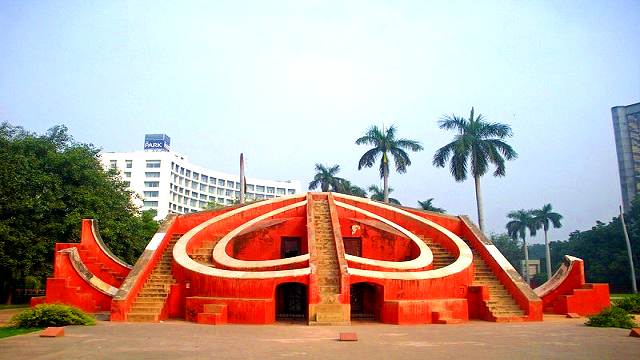


Jantar Mantar in Delhi is an astronomical observatory. It was built in 1724 by Maharaja Jai Singh II, including the other four Jantar Mantars. This building is an example of the scientific progress of ancient India. Jai Singh also built such observatories at Jaipur, Ujjain, Mathura, and Varanasi.
Jantar Mantar of Delhi is inspired by the observatory at Samarkand. During the reign of Mohammad Shah, there was a debate among Hindu and Muslim astronomers regarding the position of planets to finish it, Sawai Jai Singh got the Jantar Mantar constructed.
Various types of instruments have been installed here to measure the motion of the planets. The emperor Yantra gives information about the time and position of planets with the help of the Sun. The Egypt device can measure the smallest and biggest day of the year. The Rama Yantra and Jai Prakash Yantra describe the movement of celestial bodies.
List of instruments
The main instruments of Jantar Mantar are Samrat Yantra, NadiValya Yantra, Digansh Yantra, Mural Yantra, Egypt Yantra, etc., which are used in the study of the position and motion of the Sun and other celestial bodies. The main instruments of Jantar Mantar are Samrat Yantra, NadiValya Yantra, Digansh Yantra, Mural Yantra, Egypt Yantra, etc., which are used in the study of the position and motion of the Sun and other celestial bodies. The list of astronomical instruments made by King Jai Singh is as follows:
Emperor device
Sasthamsa
Daksinottara wall apparatus
Jai Prakasa and Kapala
River bank
Digamsa yantra
Ram yantra
Rasivalaya
Raja Jai Singh and his regent Pt. Jagannath wrote texts on this subject called ‘Yantra type’ and ‘Samrat Siddhanta. After his death at the age of 58, these observatories in the country have been a source of inspiration and information for the later constellations. The position of Venus, the brightest planet in the sky, was measured on Science Day on Saturday by a leading astronomer through the Ramayantra recently established at Jantar Mantar in Delhi.
The study included astronomers of the Nehru planetarium, as well as members of the Amateur Astronomers Association and the NGO Space.
Jantar Mantar’, a unique piece of architecture located in Connaught Place, is one of the major tourist destinations of Delhi. This is an observatory. In which 13 astronomical instruments are installed. It was designed by King Jaisingh. According to ‘De Bois’, a French writer, Raja Jai Singh himself used to make wax models of these instruments with his own hands.
National Zoological Park Delhi tourist places
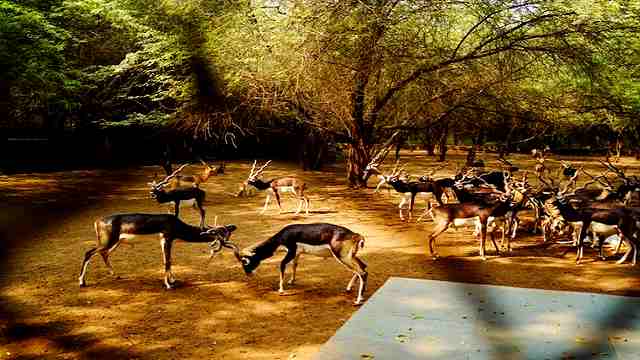


National Zoological Park Delhi (originally the Delhi Zoo) is located in the 176-acre (71 hectares) area of Old Fort in the capital city of India. This greenery area in the middle of the 16th-century congested fort of Delhi, the fort, eats a collection of different types of Jiyajantu.
Heija has about 130 species of animals and all animals kept in the garden, and the total number of inhanas is distributed about 1350. To visit the zoo, you can go to La Bijuli. Take the water of the people who come and go, but the person who eats the rest will not take it with him.
Humayun Tomb Delhi tourist places
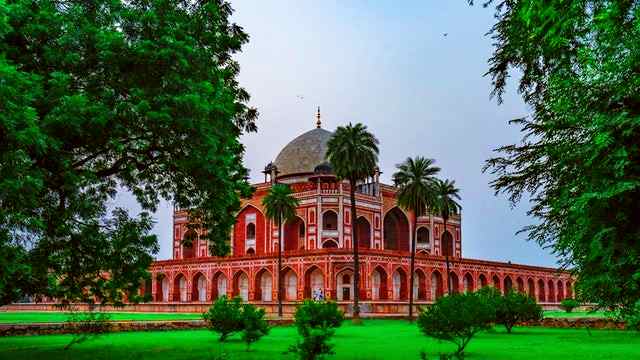


Mughal emperor Humayun’s tomb is located near the famous old fort of Delhi. The mausoleum was built in memory of Humayun by his wife Hamida Bano Begum in 1562, while the structure was designed by a Parsi architect named Mirk Mirza Ghiyath.
The mausoleum was built nine years after Humayun’s death. Humayun’s Tomb of Delhi is a major tourist attraction located in the eastern Nizamuddin area between Lodhi Road and Mathura Road and was declared as a World Heritage by UNESCO in 1993 and is the best example of Mughal architecture in India.
This garden tomb is surrounded by walls from all sides, in which beautiful gardens, small water canals, fountains, pavements, and many other things are found. There are graves of many other Mughal rulers in this boundary wall. Other tombs and buildings of this place are named -Charbagh Garden – It is a quadrangular Parsi style garden and the first of its kind in South Asia.
Barber’s Tomb – Inside the boundary wall is a mausoleum called Nai-ka-Dome, which is the tomb of a royal barber. However, due to not being inscribed on it, it is difficult to know whose grave it is. Other buildings inside Humayun’s tomb complex include Bu Halima’s tomb and garden, Isa Khan’s tomb and mosque, Neela dome, Afsarwala tomb and mosque, Chilah Nizamuddin Auliya, and Arabian inn.
Purana Quila Delhi tourist places
Purana Quila of Delhi is an interesting tourist place. Apart from being the oldest of all the forts of Delhi, it is also the oldest of all the structures of Delhi and is situated at a place called Indraprastha which was a famous city. According to legend, this ancient fort was discovered by the Pandavas on the banks of river Yamuna which is more than 5000 years old and was built before the Mahabharata period. Researchers have confirmed that Chahar Diwali of Purana Qila had a small hamlet named Indraprastha inside the wall. It is also believed that Humayun’s capital day Din Chhaan was also situated here which was later renovated by the first Afghan ruler of India and named it Shergarh.
With this, Akbar’s coronation took place in this palace after the last Hindu ruler of India, Emperor Hem Chandra Vikramaditya alias Hemu, defeated Akbar’s forces in Delhi and Agra in 1556 AD. However, this fort is believed to be inauspicious for rulers like Humayun, Sher Shah, and Hemachandra, who ruled from here. There are many interesting buildings around the Purana Qila including the Qila-e-Kuhna Mosque built by Sher Shah, the octagonal red sandstone double-storeyed Lion Sher Mandal, the mosque of Karl Manzil built by MahamAnga, the mother of Emperor Akbar, and the southern door for Shergarh. Are included.
There are bastions on both sides at the three gates of the fort’s strong and thick walls. These walls are 18 meters high and one and a half km long, with three arched gateways called Bada Darwaza in the west, Humayun Darwaza in the south, and Taluk Gate, also known as prohibition gate. All three entrances are huge two-story structures with bastions on either side, as well as balconies or jharokhas and sambhayukt mandapas. Presently Purana Qila is a place where a visual audio show of Delhi’s history is organized every evening.
Nehru Planetarium Delhi tourist places
The Nehru Planetarium, built-in Teen Murti Bhawan, is a place to visit if you are interested in astronomy or love the moon stars, and the sky. You can experience the entire Galaxy by sitting under the roof of the Planetarium in a semi-circle. You will feel as if you are sitting in the space between the moon stars.
Jama Masjid Delhi tourist places
Jama Masjid is one of the oldest and largest mosques in India. This mosque was built by Emperor Shah Jahan. The construction of this mosque was started in 1650 which was completed in 1656. This mosque is located on Chowri Bazar Road.
The mosque is one of the main attractions of Old Delhi. 25,000 devotees can pray together in this huge mosque. It has three majestic gates, four towers 40 meters high, made of red sandstone and white marble. There are about 260 beautifully carved pillars in this mosque that have the impression of Hindu and Jain architecture.
The floor of the mosque is covered with white and black marble which looks like an ornate Muslim prayer mat. This mosque is situated on a 5-foot high platform and is probably the largest mosque in India. The mosque has many relics, one of which is an ancient copy of the Quran written on a deerskin. It is placed at the northern door of the mosque. This mosque is in front of the Red Fort in Delhi.
Delhi Haat Delhi tourist places
If you are fond of ‘art’ and ‘handicrafts’ and are fond of both of them, then you must visit Delhi Haat in Delhi. The site is open with the joint efforts of the Delhi Tourism and Transport Development Corporation, NMDC, DC (Handicrafts) and DC (Handlooms), Ministry of Textiles (Government of India), and Ministry of Tourism.
It is to be known that the purpose of making this place is to make Indian arts, crafts, and culture known to people from outside the country and coming from outside. Pottery sold at Delhi Haat. If you are fond of handmade goods, then this place is for you.
Safdarjung Tomb Delhi tourist places
Safdarjung’s tomb in Delhi is the last enclosed tomb of Delhi. This mausoleum was built in the year 1753 by Nawab ShujaudDaula of Awadh in memory of his father Safdarjung. The tomb is a white mausoleum which is considered to be the last lamp of Mughal architecture.
The entrance of this 300 square kilometer monument is built of beautiful red sandstone with impressive shape. The central part of the grave will make your eyes relaxed with a grand display of its colors, which will leave you stunned. Nine other mini graves located in this mausoleum will also attract your attention and you will be mesmerized by seeing them.
This tomb is a living example of ancient Mughal architecture which is very beautiful. If you are in Delhi then we would advise you to visit Safdarjung’s Tomb, the huge walls, tall fountains, Mughal gardens present here will not stop you from praising the Mughal style.
There are sixteen sections in this tomb whose names will always be in your mind like Moti Mahal, Jungle Mahal, Badshah’s choice. This tomb opens seven days from sunrise to sunset. The name of this tomb is still used around this place.
How to Reach Delhi
Delhi By Air:
Indira Gandhi International(IGI), is situated 15km away from the main city in New Delhi city with good connectivity with other major airports Mumba, Bangalore, Hyderabad, Kolkata, Chennai, etc. Private taxis, Car, Ola, Uber are available to reach desire locations or hotels in Delhi.
New Delhi By Train:
New Delhi (NDLS) railway station is the main railhead in Delhi with good connectivity with other states and cities. Nizamuddin railway station(NZM), Delhi Sabzi Mandi (SZM), Delhi Cantt(DEC), etc is also another major railway station in Delhi. After getting down at the station car, taxis, auto are available to reach hotels or desire locations.
New Delhi By Bus:
One can get a regular bus from other Major cities and reach New Delhi. Interstate bus terminus(ISBT), Anand vihar bus terminus, and Kashmiri gate Bus terminus are manor bus stand to reach Delhi. One can book online and offline to reach Delhi. Share taxi, Ola, Uber, rental car, or cab is available to reach hotels.
Where to stay in New Delhi
Connaught Place (CP) is located centrally in Delhi with good connectivity with other tourist places. One can easily get good hotels and It cost under 1000-1500/-per night depends on pick and off-seasons. It also gives you easy check-in and check-out option too, because the railway station, ISBT bus stand, and airport are also situated nearer. This travel itinerary is based on Connaught place (CP).
Best Time To Visit New Delhi
It is among one of the places where visitors visit throughout the year. Summer temperature reaches sometimes 45 degrees Celcius, rainy season receives heavy rainfall. One can avoid visiting New Delhi in these two seasons. The period from October to February is regarded as the best time to visit New Delhi or the winter season considers as the best time to visit New Delhi.
New Delhi travel guide
Book your hotel near Cannaut Place which is located centrally. From there you can book a taxi for sightseeing also. It is also the best to place to check in and check out.
New Delhi has many places to visit, one can plan as per city and activity. In this article we are covering 17 places, which it can cover in 3 days or 4 days, it is up to you. One can plan as per your own choice.
- Day1 : Day 1 can cover by using local taxi as one has to cover only 7-10 km and all situated nearer to Cannaut place. One can split these places in 2 days also.
- Day 2 : For Day 2 One can book full day car for sightseeing and One has to cover long distance with New Delhi famous places.
- Day 3 : One can use local taxi Ola or Uber to reach Red fort than Akshardham temple and spend some time in Okhla bird Sancturay.
New Delhi Itinerary
Places to visit New Delhi in 5-6 days
New Delhi Tourist places day 1
- Cannaught Palace
- Jantar Mantar
- Sri Gurudwara Bangla Shahib
- Rastrapathi Bhavan
- Parliament Bhavan
- India Gate
- Purana Quila
- National Zoo Park
New Delhi Tourist places days 2
- Safdarjung tomb
- Qutub Minar
- Lotus Temple
- Humayun Tomb
- Purana quila
New Delhi tourist places days 3
- Jama Masjid
- Red Fort
- Akshardham Temple
- Okhla Bird Sactuary
New Delhi tourist places more attraction
- National Museum
- Nehru Planetorium
- Birla Mandir
- Dehi Haat
New Delhi Travel Cost for 1 Couple for 1 Night & 3 Days.
- Food-2 Days : 1000/-
- Travel Cost : 5000/-
- Hotel-2 Days : 2500/-
- Other Activity : 3000/-
Total cost around 4500-9000/-Rs for One Couple for 1 Night & 2 Days. You Can Negotiate and plan your own trip as per Distance, Enjoyment, Food, Transport, and stay.
If you fill, it is useful for you, please like, subscribe, and follow this page.
Till enjoy, be happy, and Jay Hind.


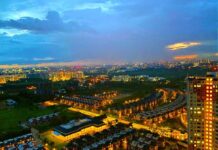

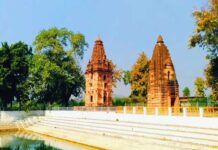
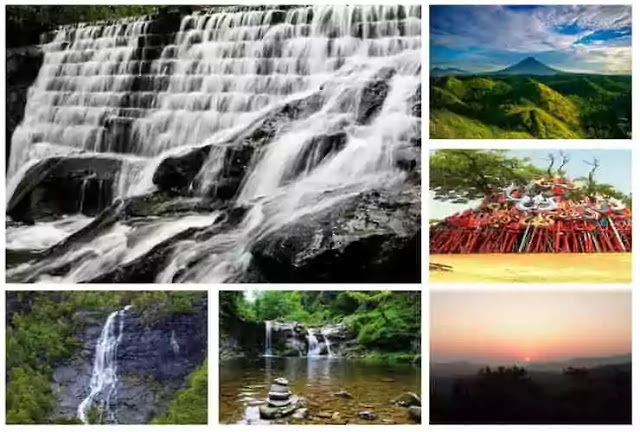

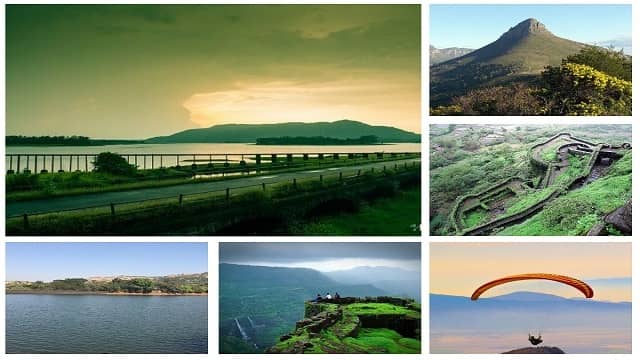
17 Famous Delhi Tourist Places » Holidayinfy.com
[url=http://www.gz9491a83526nq8gia7122awznko6x2qs.org/]uzlnklkdzee[/url]
azlnklkdzee
zlnklkdzee http://www.gz9491a83526nq8gia7122awznko6x2qs.org/